The Intel Broadwell Desktop Review: Core i7-5775C and Core i5-5675C Tested (Part 1)
by Ian Cutress on June 2, 2015 7:45 AM ESTProfessional Performance: Linux
Built around several freely available benchmarks for Linux, Linux-Bench is a project spearheaded by Patrick at ServeTheHome to streamline about a dozen of these tests in a single neat package run via a set of three commands using an Ubuntu 11.04 LiveCD. These tests include fluid dynamics used by NASA, ray-tracing, OpenSSL, molecular modeling, and a scalable data structure server for web deployments. We run Linux-Bench and have chosen to report a select few of the tests that rely on CPU and DRAM speed.
Due to our limited testing time and other issues, only the i7-5775C was processed in our Linux tests. These should be updated for Part 2.
C-Ray: link
C-Ray is a simple ray-tracing program that focuses almost exclusively on processor performance rather than DRAM access. The test in Linux-Bench renders a heavy complex scene offering a large scalable scenario.
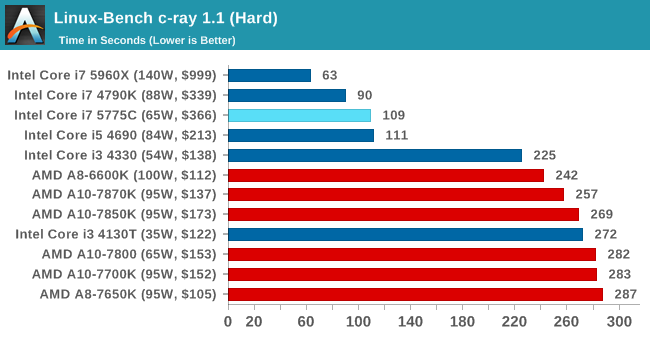
NAMD, Scalable Molecular Dynamics: link
Developed by the Theoretical and Computational Biophysics Group at the University of Illinois at Urbana-Champaign, NAMD is a set of parallel molecular dynamics codes for extreme parallelization up to and beyond 200,000 cores. The reference paper detailing NAMD has over 4000 citations, and our testing runs a small simulation where the calculation steps per unit time is the output vector.
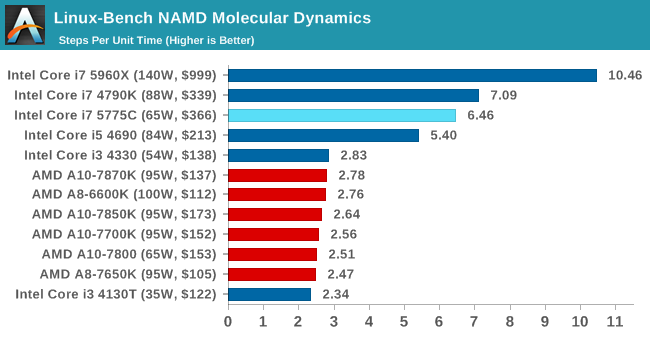
NPB, Fluid Dynamics: link
Aside from LINPACK, there are many other ways to benchmark supercomputers in terms of how effective they are for various types of mathematical processes. The NAS Parallel Benchmarks (NPB) are a set of small programs originally designed for NASA to test their supercomputers in terms of fluid dynamics simulations, useful for airflow reactions and design.
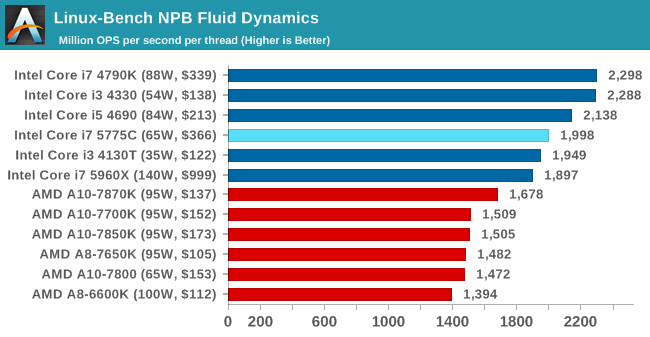
Redis: link
Many of the online applications rely on key-value caches and data structure servers to operate. Redis is an open-source, scalable web technology with a b developer base, but also relies heavily on memory bandwidth as well as CPU performance.
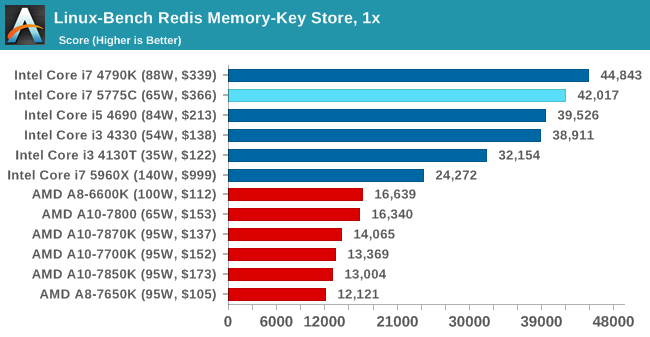
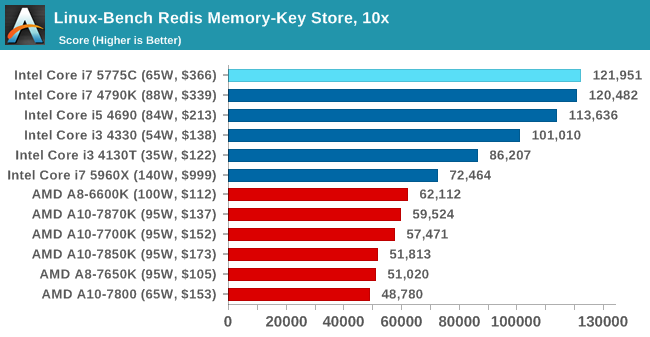
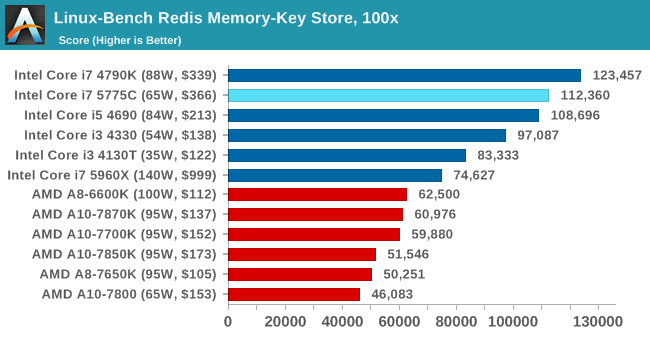










196 Comments
View All Comments
Jumangi - Tuesday, June 2, 2015 - link
Completely worthless release for gamers and PC enthusiasts...another year goes by with no reason to upgrade to a new CPU. Were officially back to the dark days before AMD kicked Intel in the nuts with the Athlon64 and made them have to compete.So sad...
Peichen - Tuesday, June 2, 2015 - link
Skylake is coming in 2 months for gamers. Today's release is for system builders that needs a stopgap. You shouldnt buy into AMD's PR campaign that you need to buy AMD to support innovation. Intel is doing that all by itself.PubFiction - Wednesday, July 1, 2015 - link
I agree 2500K and 2600K here haven't had a single reason to even be tempted to upgrade. The only good that has come of this is that now days I have gobs of cash to spend on GPUs, I guess this explains why NVidia can charge $999 for a GPU now and sell out.jjj - Tuesday, June 2, 2015 - link
Sad that Krzanich continues with this strategy of making products nobody needs and abusing their monopoly to charge way too much.Seriously, just 4 cores and a GPU that can't even do 1080p at those prices? Same die they could have fitted 12 cores and no GPU but we'll never get that because Intel has no interest in making good chips and regulators are all dead.
They'll choke on it, it's unavoidable.
TallestJon96 - Tuesday, June 2, 2015 - link
I only see this being good in all in ones and mini PCs. I fully expect Apple to announce a broadwell refresh for their iMacs before the year ends.Too bad, because I'm looking to upgrade from an i3-2120 to a low-ish power i5, and this fits the bill except that the integrated graphics drive the price through the roof. I'm hoping for a 65w vanilla i5 that performs well, and this is close, but not quite right.
MikhailT - Tuesday, June 2, 2015 - link
I somehow doubt it. They already refreshed the iMac a bit and dropped the prices for the year. They doesn't update as often as everyone else, they're happy to wait.I expect Apple to go full Skylake next year.
Peichen - Tuesday, June 2, 2015 - link
Well, AMD should pay or sue Intel to keep Intel from integrating GT3e GPU into sub $150 CPUs. That would kill all AMD's market above $80.MikhailT - Tuesday, June 2, 2015 - link
WTF, or how about AMD complete to make better stuff instead.Peichen - Tuesday, June 2, 2015 - link
AMD cannot compete. They are so far behind Intel on R&D and even vision and theories it has no chance of catching up to Intel any time soon. The CPU department is kept afloat by the GPU department and that isn't going well either.silverblue - Tuesday, June 2, 2015 - link
AMD doesn't have the money. The main reason it's behind the curve is because they couldn't exactly bring out something to replace Bulldozer and as such had to milk it for all it's worth so it wasn't a complete waste of time that could'v dragged them under. If AMD had the resources, I think we'd have seen a replacement for Bulldozer by now.AMD's GPU tech is hampered by the process node and the lack of eDRAM/HBM. Carrizo may make a large difference in terms of power consumption plus a lesser difference in terms of performance, but AMD stands to benefit a lot from throwing some memory on die. Coupled with better compression, they'll have a more competitive product, but I think Iris Pro 6200 has the leader for the next 12-18 months (even if Carrizo does come to the desktop, will its performance be that much improved over Kaveri? I'm not so sure).
I think we need high quality tests for the iGPUs to see how that makes a difference. Intel may lead by even more.